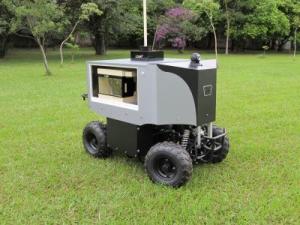Nov 7 2013
University of Texas at San Antonio Chemistry Professor Carlos Garcia, UTSA Physics Professor Arturo Ayon and HJ Science & Technology Inc. of Santa Clara, Calif. have been awarded more than $300,000 in NASA funding to build the fourth prototype of a "lab-on-a-robot" (LOAR). The Rover-like prototype will be designed to conduct on-site planetary compositional analysis.
 UTSA chemistry professor Carlos Garcia, UTSA physics professor Arturo Ayon and HJ Science & Technology Inc. of Santa Clara, Calif., have been awarded more than $300,000 in NASA funding to build the fourth prototype of a "lab-on-a-robot." The rover-like prototype will be designed to conduct on-site planetary compositional analysis. Credit: UTSA Courtesy Photo
UTSA chemistry professor Carlos Garcia, UTSA physics professor Arturo Ayon and HJ Science & Technology Inc. of Santa Clara, Calif., have been awarded more than $300,000 in NASA funding to build the fourth prototype of a "lab-on-a-robot." The rover-like prototype will be designed to conduct on-site planetary compositional analysis. Credit: UTSA Courtesy Photo
Utilizing wireless technology, the current LOAR is able to navigate to a global position location, acquire an air sample, perform the analysis and send the data to a remote station without exposing the analyst to the testing environment.
Additionally it's equipped with a chemical sensor that sits atop a highly integrated mobile platform. The chemical sensor contains a microchip with the capacity to determine the composition of a sample in a few minutes.
"This "lab on a robot" could lay the groundwork for the next generation of NASA robotic missions by allowing for the analysis of air samples or biological compounds without the threat of danger to a human operator," said Garcia.
Additionally, the LOAR could also be used commercially to monitor environmental pollutants that could pose a threat to human health or the environment. Evaluation of samples on-site would provide real-time data analysis and reduce the time and costs associated when utilizing conventional laboratory techniques.
The original prototype, built in 2008 was a collaboration between UTSA Chemistry Professor Carlos Garcia and UTSA Physics Professor Arturo Ayon in the Micro-ElectroMechanical systems (MEMS) laboratory. Subsequent prototypes were joint efforts with the University of Sao Paulo, Brazil. A member of that team, Eric Tavares da Costa, will join Garcia's lab to work on the latest LOAR prototype.
The NASA funding will be directed to build the fourth upgraded prototype, using the experience collected during the development of previous versions that were funded through UTSA and the Department of Defense's Office of Naval Research.